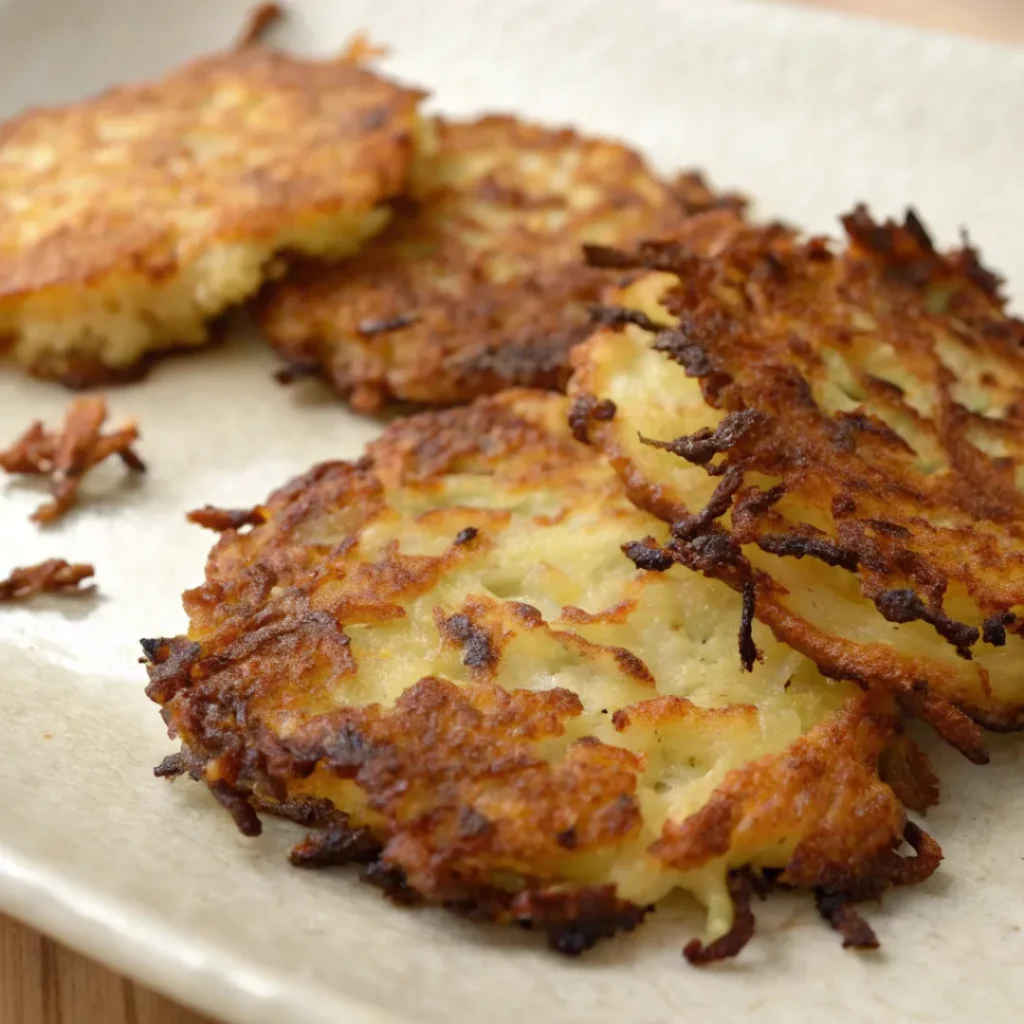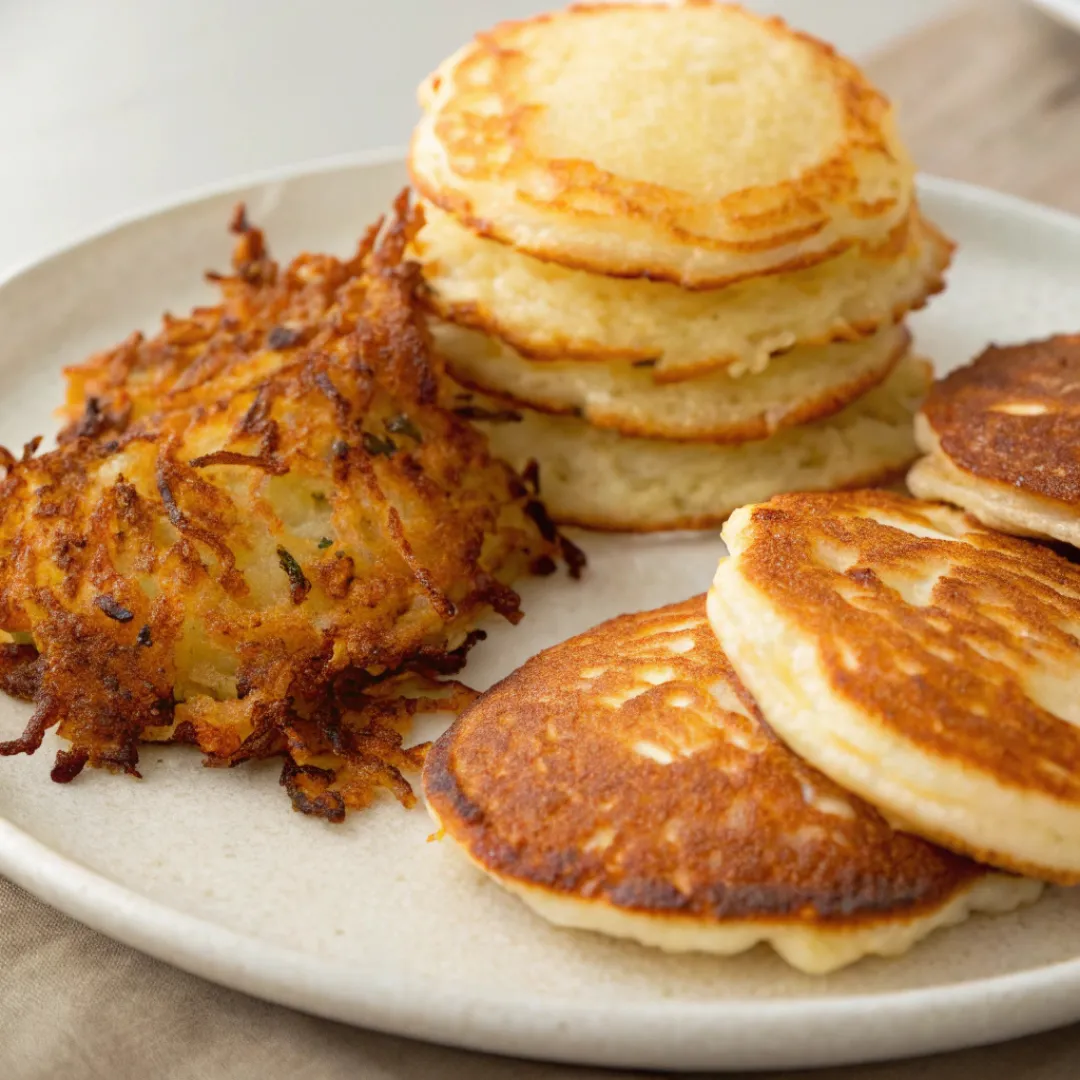Potato latkes and potato pancakes are beloved comfort foods that share similarities, but they’re far from the same. While both are made with potatoes and have a golden, crispy exterior, the two have different histories, ingredients, textures, and uses. If you’ve ever wondered, “What is the difference between potato latkes and pancakes?” this guide will answer your question.
In this article, we’ll dive into the unique aspects of both dishes. From their origins and core ingredients to variations, preparation techniques, and serving suggestions, you’ll discover everything you need to know to appreciate and differentiate between potato latkes and pancakes.
Origins and Cultural Significance
The History of Potato Latkes in Jewish Cuisine
Latkes have a strong cultural connection to Jewish tradition, especially during Hanukkah. The custom of eating fried foods during Hanukkah honors the miracle of oil, which kept the menorah lit for eight days with only a small amount of oil. Potato latkes, often made with grated potatoes, onions, and flour, are fried in oil as part of this celebration.
Latkes originated in Eastern Europe, where potatoes were a staple crop. Over time, this dish became a favorite comfort food, symbolizing warmth and family gatherings, particularly during the winter season.
Potato Pancakes in Global Cuisines
Potato pancakes are not limited to Jewish cuisine and are found in various cultures. For example, German potato pancakes, or kartoffelpuffer, are commonly served with applesauce or sour cream. Polish placki ziemniaczane are often paired with mushroom sauce or meat, while Irish boxty pancakes are made with both mashed and grated potatoes for a unique texture.

These pancakes vary in ingredients and cooking styles across regions, with each culture adding its own twist.
Key Ingredient Differences
While latkes and potato pancakes share some core ingredients, they differ in certain components and proportions:
Potatoes
Both latkes and potato pancakes start with potatoes as the main ingredient. Latkes traditionally use grated potatoes, which gives them a crispy texture. Potato pancakes can be made with either grated or mashed potatoes, resulting in a smoother consistency.
Flour or Starch
Both dishes use a binder like flour or potato starch. Latkes typically require a small amount of flour, while some potato pancake recipes use more flour for a denser texture. In some recipes, breadcrumbs are added to the batter to increase crispiness.
Eggs
Eggs act as a binding agent in both dishes, helping the ingredients stick together. Latkes generally use a bit more egg, giving them a lighter, more delicate texture. Potato pancakes may use fewer eggs, as the batter itself is denser.
Onion and Seasoning
Latkes almost always include grated onion for added flavor, while potato pancakes may or may not include onions. Latkes are also seasoned with salt and pepper, while potato pancakes often include additional seasonings like garlic, herbs, or even nutmeg, depending on the cultural recipe.
Texture and Consistency
One of the main differences between latkes and potato pancakes is their texture:
Latkes: Crispy and Textured
Latkes are known for their crispy, almost lacy edges and slightly chunky texture. The grated potatoes create a rustic appearance and a crunch that’s unique to latkes. The combination of onions, flour, and eggs gives latkes a balanced structure that’s crispy on the outside but soft on the inside.

Potato Pancakes: Smooth and Tender
Potato pancakes, especially those made with mashed potatoes, have a smoother, more uniform texture. They’re usually thicker than latkes and may have a softer, creamy interior. This makes them more versatile for adding various seasonings and ingredients without losing their consistency.
Preparation and Cooking Techniques
The techniques for making latkes and potato pancakes differ slightly, especially in how the potatoes are prepared and fried:
Latkes
- Grate the Potatoes and Onion: Grate the potatoes and onion, then squeeze out excess water to help achieve a crispy texture.
- Mix with Flour and Egg: Combine the grated potatoes with flour, eggs, and salt and pepper.
- Shallow Fry in Oil: Heat a layer of oil in a skillet and spoon small mounds of the mixture into the pan, flattening each one slightly. Fry until golden brown and crispy on each side.
For detailed tips on making perfect latkes, including achieving the ideal texture and crispiness, check out this guide from Serious Eats: How to Make Latkes.
Potato Pancakes
- Grate or Mash the Potatoes: Use either grated or mashed potatoes, depending on the desired texture.
- Add Flour, Egg, and Seasonings: Mix in flour, eggs, and seasonings like garlic or herbs.
- Pan-Fry with Less Oil: Unlike latkes, potato pancakes often require less oil for frying. They’re cooked until golden and set on each side.
Popular Variations and Add-ins
Both latkes and potato pancakes can be customized in countless ways to create unique flavors and textures. Here are some popular variations:
Latke Variations:
- Zucchini Latkes: Replace some or all of the potatoes with grated zucchini for a lighter, slightly sweet version. These pair well with a dollop of Greek yogurt or tzatziki.
- Carrot and Parsnip Latkes: Incorporate grated carrots, parsnips, or other root vegetables to add color and natural sweetness, enhancing the flavor profile. This variation brings an earthy, rich twist and pairs beautifully with sour cream or applesauce.
- Sweet Potato Latkes: Swap regular potatoes for sweet potatoes, adding a subtle sweetness and a vibrant orange hue. Sweet potato latkes are delicious with cinnamon-spiced applesauce or maple syrup.
Potato Pancake Variations:
- Cheesy Potato Pancakes: Mix shredded cheese like cheddar, mozzarella, or Parmesan into the batter for a rich, gooey texture and savory flavor. Cheesy potato pancakes are delightful with salsa or marinara sauce.
- Vegetable Potato Pancakes: Add grated vegetables like carrots, spinach, or bell peppers to increase nutrition and add bursts of color. These veggie-packed pancakes are great with a tangy yogurt or a simple green salad on the side.
- Spiced Potato Pancakes: Season with spices such as garlic powder, thyme, rosemary, or smoked paprika for added depth and warmth. Spiced potato pancakes go well with dipping sauces like garlic aioli or sriracha mayo.
These variations make it easy to personalize latkes and potato pancakes, transforming them into versatile dishes suitable for any meal or occasion.
Serving Suggestions and Toppings
While both dishes can be enjoyed plain, they’re often served with various toppings and accompaniments:
Latkes
- Traditional Toppings: Applesauce and sour cream are classic choices.
- Savory Options: Serve with smoked salmon, a dollop of Greek yogurt, or a sprinkle of chives.
- Sweet Touches: Try with a drizzle of honey or a dusting of powdered sugar.
Potato Pancakes
- Savory Toppings: Sour cream, chive cream cheese, or a fried egg are popular choices.
- Sweet Toppings: Serve with applesauce, cinnamon, or even maple syrup for a breakfast-style potato pancake.
- Hearty Pairings: Pair with sausages, stews, or hearty vegetable sides for a filling meal.
Health Considerations
Nutritional Differences
Potato latkes and potato pancakes are both high in carbohydrates and provide a good source of energy. However, because latkes are traditionally fried, they may contain more oil and fat than potato pancakes, which are often cooked with less oil.
Tips for Healthier Versions
- Baking Instead of Frying: Bake the pancakes on a parchment-lined sheet for a lower-fat option.
- Using Alternative Flours: Use whole-wheat or almond flour for added fiber and nutrients.
- Adding Vegetables: Incorporate additional grated vegetables for more vitamins and minerals.
Frequently Asked Questions
Can I use the same recipe for both latkes and potato pancakes?
While you can make adjustments to use similar ingredients, the texture and cooking techniques may vary. If you prefer crispy, textured results, go for latkes. For a smoother texture, opt for potato pancakes.
How do I make gluten-free versions?
Substitute all-purpose flour with gluten-free flour or potato starch for both latkes and potato pancakes.
Can I make vegan versions of latkes and potato pancakes?
Yes, you can replace eggs with a flax or chia egg (1 tablespoon of ground flax or chia seeds mixed with 3 tablespoons of water).
Can I freeze potato latkes or pancakes?
Yes, both latkes and potato pancakes freeze well. Place a layer of parchment paper between each pancake, store in an airtight container, and reheat in the oven when ready to serve.
Conclusion
In summary, while potato latkes and potato pancakes share some similarities, they each have unique characteristics that make them distinct. Latkes are crispy, rustic, and closely tied to Jewish tradition, while potato pancakes have a softer texture and can be enjoyed in various cultural settings. Understanding these differences allows you to appreciate the unique flavors and textures each dish brings to the table.
Whether you’re preparing latkes for a holiday celebration or serving potato pancakes as a versatile side dish, both offer delicious ways to enjoy the humble potato. Experiment with toppings, add-ins, and cooking techniques to make each dish your own!

